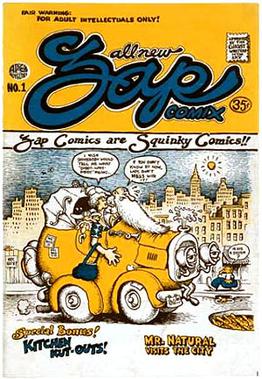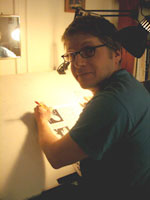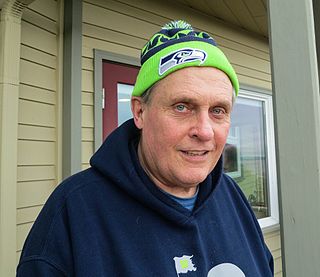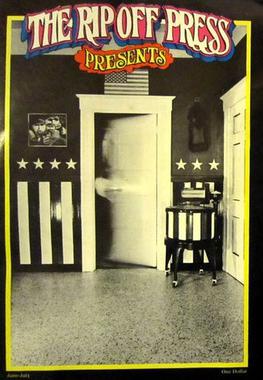
Robert Dennis Crumb is an American cartoonist who often signs his work R. Crumb. His work displays a nostalgia for American folk culture of the late 19th and early 20th centuries, and satire of contemporary American culture.

Underground comix are small press or self-published comic books that are often socially relevant or satirical in nature. They differ from mainstream comics in depicting content forbidden to mainstream publications by the Comics Code Authority, including explicit drug use, sexuality, and violence. They were most popular in the United States in the late 1960s and 1970s, and in the United Kingdom in the 1970s.

A graphic novel is a long-form, fictional work of sequential art. The term graphic novel is often applied broadly, including fiction, non-fiction, and anthologized work, though this practice is highly contested by comics scholars and industry professionals. It is, at least in the United States, typically distinct from the term comic book, which is generally used for comics periodicals and trade paperbacks.

Peter Bagge is an American cartoonist whose best-known work includes the comics Hate and Neat Stuff. His stories often use black humor and exaggerated cartooning to dramatize the reduced expectations of middle-class American youth. He won two Harvey Awards in 1991, one for best cartoonist and one for his work on Hate. In recent decades Bagge has done more fact-based comics, everything from biographies to history to comics journalism. Publishers of Bagge's articles, illustrations, and comics include suck.com, MAD Magazine, toonlet, Discover, and the Weekly World News, with the comic strip Adventures of Batboy. He has expressed his libertarian views in features for Reason.

The Ultimates is a superhero comic book series published by Marvel Comics and created by writer Mark Millar and artist Bryan Hitch, which first started publication from The Ultimates #1, as part of the company's Ultimate Marvel imprint. The series is a modernized re-imagining of Marvel's long-running Avengers comic-book franchise, centering around an elite military task-force of super-humans and special agents organized by the U.S. government, known as the Ultimates, to combat growing threats, both of human and non-human origin, to the country and in turn, the world, as they slowly learn to work together and form a family-like bond with each other, despite their differing natures and personalities.

Harvey Kurtzman was an American cartoonist and editor. His best-known work includes writing and editing the parodic comic book Mad from 1952 until 1956, and writing the Little Annie Fanny strips in Playboy from 1962 until 1988. His work is noted for its satire and parody of popular culture, social critique, and attention to detail. Kurtzman's working method has been likened to that of an auteur, and he expected those who illustrated his stories to follow his layouts strictly.

Jeff Smith is an American cartoonist. He is best known as the creator of the self-published comic book series Bone.

Raw was a comics anthology edited by Art Spiegelman and Françoise Mouly and published in the United States by Mouly from 1980 to 1991. It was a flagship publication of the 1980s alternative comics movement, serving as a more intellectual counterpoint to Robert Crumb's visceral Weirdo, which followed squarely in the underground tradition of Zap and Arcade. Along with the more genre-oriented Heavy Metal it was also one of the main venues for European comics in the United States in its day.
Notable events of 2005 in comics. See also List of years in comics.
Notable events of 2006 in comics. See also List of years in comics.
Shary Flenniken is an American editor-writer-illustrator and underground cartoonist. After joining the burgeoning underground comics movement in the early 1970s, she became a prominent contributor to National Lampoon and was one of the editors of the magazine for two years.

Trina Robbins is an American cartoonist. She was an early participant in the underground comix movement, and one of the first female artists in that movement. She is a member of the Will Eisner Hall of Fame.

Josh Neufeld is an alternative cartoonist known for his comics journalism work on subjects like graphic medicine, equity, and technology; as well as his collaborations with writers like Harvey Pekar and Brooke Gladstone. He is the writer/artist of A.D.: New Orleans After the Deluge, and the illustrator of The Influencing Machine: Brooke Gladstone on the Media.

Australian comics have been published since 1908 and Australian comics creators have gone to produce influential work in the global comics industry,

Ed Subitzky, full name Edward Jack Subitzky, is an American writer and artist. He is best known as a cartoonist, comics artist, and humorist. He has worked as a television comedy writer and performer, a writer and performer of radio comedy, and a writer of radio drama. He has also created comedy and humor in other media. Subitzky is a member of the Screen Actors Guild-American Federation of Television and Radio Artists, and the Writers Guild of America.
Michel Choquette is a Canadian humorist who has written for print, for television and for film, and a comedian who has performed for television.

Dennis P. Eichhorn was an American writer, best known for his adult-oriented autobiographical comic book series Real Stuff. His stories, often involving, sex, drugs, and alcohol, have been compared to those of Jack Kerouac, Ken Kesey, and Charles Bukowski.

The Rip Off Review of Western Culture was an underground comics magazine published by Rip Off Press and produced out of San Francisco, California. It published three issues in 1972. The publication was historically significant in that it brought together the work of many noteworthy underground artists and writers.

The Best of National Lampoon #3 was an American humor book published in 1973. The book was an anthology of articles from National Lampoon magazine. It was sold on newsstands, but was published in parallel with the regular issues of the magazine. The book is a "best-of" compilation of pieces that had already been published in the National Lampoon. The pieces were from various 1971 and 1972 (monthly) issues of the magazine.
Krystine Kryttre is an American alternative comics artist, painter, animator, writer, and performer from San Francisco. currently based in Los Angeles. Her work is dark, often explicit, and visually distinctive." Her work has been exhibited in galleries since the late 1980s, including a number of solo shows in Los Angeles.















